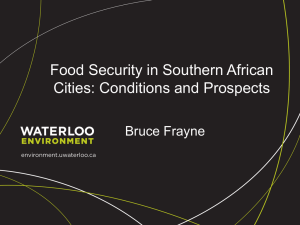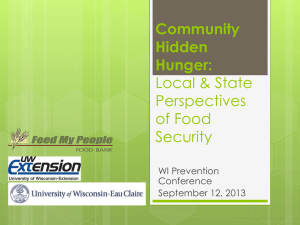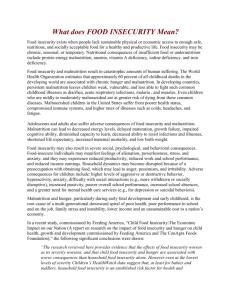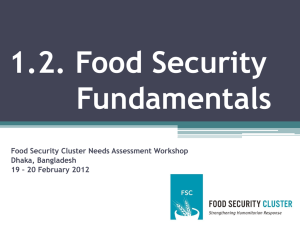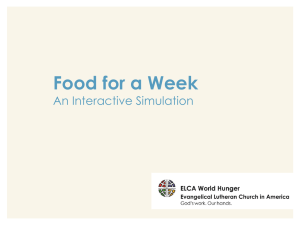Food insecurity and access - Institute for Research on Poverty
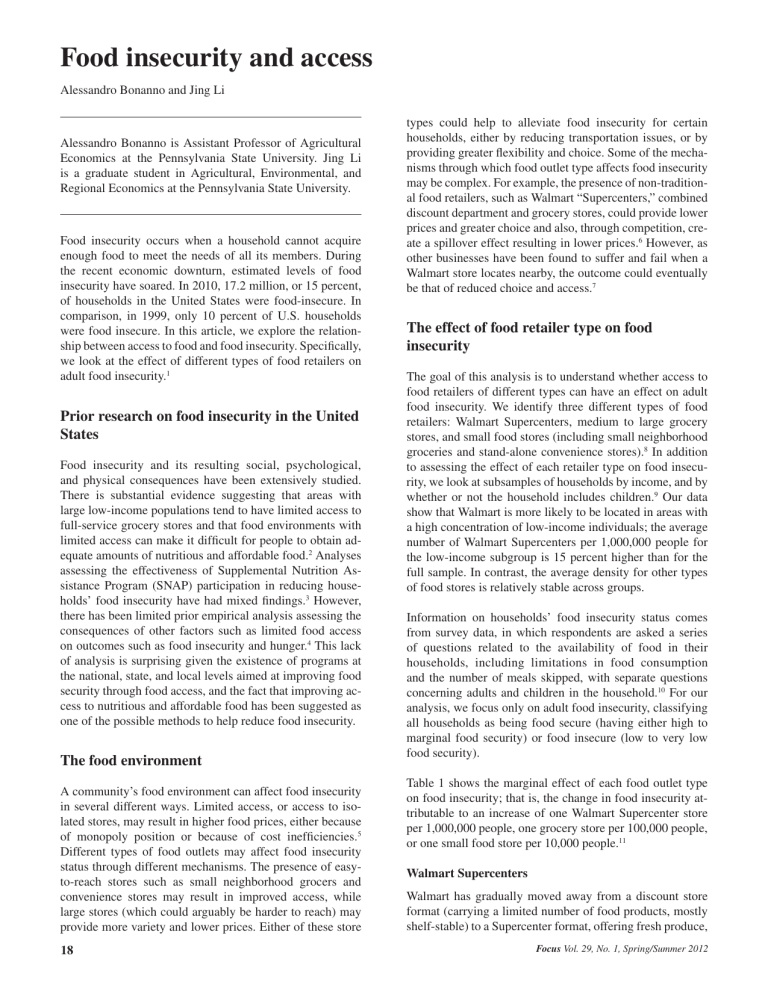
Food insecurity and access
Alessandro Bonanno and Jing Li
Alessandro Bonanno is Assistant Professor of Agricultural
Economics at the Pennsylvania State University. Jing Li is a graduate student in Agricultural, Environmental, and
Regional Economics at the Pennsylvania State University.
Food insecurity occurs when a household cannot acquire enough food to meet the needs of all its members. During the recent economic downturn, estimated levels of food insecurity have soared. In 2010, 17.2 million, or 15 percent, of households in the United States were food-insecure. In comparison, in 1999, only 10 percent of U.S. households were food insecure. In this article, we explore the relationship between access to food and food insecurity. Specifically, we look at the effect of different types of food retailers on adult food insecurity.
1
Prior research on food insecurity in the United
States
Food insecurity and its resulting social, psychological, and physical consequences have been extensively studied.
There is substantial evidence suggesting that areas with large low-income populations tend to have limited access to full-service grocery stores and that food environments with limited access can make it difficult for people to obtain adequate amounts of nutritious and affordable food.
2 Analyses assessing the effectiveness of Supplemental Nutrition Assistance Program (SNAP) participation in reducing households’ food insecurity have had mixed findings.
3 However, there has been limited prior empirical analysis assessing the consequences of other factors such as limited food access on outcomes such as food insecurity and hunger.
4 This lack of analysis is surprising given the existence of programs at the national, state, and local levels aimed at improving food security through food access, and the fact that improving access to nutritious and affordable food has been suggested as one of the possible methods to help reduce food insecurity.
The food environment
A community’s food environment can affect food insecurity in several different ways. Limited access, or access to isolated stores, may result in higher food prices, either because of monopoly position or because of cost inefficiencies.
5
Different types of food outlets may affect food insecurity status through different mechanisms. The presence of easyto-reach stores such as small neighborhood grocers and convenience stores may result in improved access, while large stores (which could arguably be harder to reach) may provide more variety and lower prices. Either of these store
18 types could help to alleviate food insecurity for certain households, either by reducing transportation issues, or by providing greater flexibility and choice. Some of the mechanisms through which food outlet type affects food insecurity may be complex. For example, the presence of non-traditional food retailers, such as Walmart “Supercenters,” combined discount department and grocery stores, could provide lower prices and greater choice and also, through competition, create a spillover effect resulting in lower prices.
6 However, as other businesses have been found to suffer and fail when a
Walmart store locates nearby, the outcome could eventually be that of reduced choice and access.
7
The effect of food retailer type on food insecurity
The goal of this analysis is to understand whether access to food retailers of different types can have an effect on adult food insecurity. We identify three different types of food retailers: Walmart Supercenters, medium to large grocery stores, and small food stores (including small neighborhood groceries and stand-alone convenience stores).
8 In addition to assessing the effect of each retailer type on food insecurity, we look at subsamples of households by income, and by whether or not the household includes children.
9 Our data show that Walmart is more likely to be located in areas with a high concentration of low-income individuals; the average number of Walmart Supercenters per 1,000,000 people for the low-income subgroup is 15 percent higher than for the full sample. In contrast, the average density for other types of food stores is relatively stable across groups.
Information on households’ food insecurity status comes from survey data, in which respondents are asked a series of questions related to the availability of food in their households, including limitations in food consumption and the number of meals skipped, with separate questions concerning adults and children in the household.
10 For our analysis, we focus only on adult food insecurity, classifying all households as being food secure (having either high to marginal food security) or food insecure (low to very low food security).
Table 1 shows the marginal effect of each food outlet type on food insecurity; that is, the change in food insecurity attributable to an increase of one Walmart Supercenter store per 1,000,000 people, one grocery store per 100,000 people, or one small food store per 10,000 people.
11
Walmart Supercenters
Walmart has gradually moved away from a discount store format (carrying a limited number of food products, mostly shelf-stable) to a Supercenter format, offering fresh produce,
Focus Vol. 29, No. 1, Spring/Summer 2012
Table 1
Average Marginal Effect of Type of Food Outlet on Adult Food Insecurity
Store Type
Walmart Supercenters
Medium- to Large-Sized Grocery Stores
Small Food Stores
All Households
0.02%
-1.02%***
-1.09%**
Low-Income
Households
0.04%
-1.15%
-4.01%**
Households with Children
-0.17%
-1.39%**
-1.71%**
Low-Income Households with Children
0.35%
-0.64%
-1.54%
Notes: Statistical significance levels are indicated as * = 10%; ** = 5%; *** = 1%. Households are classified as low-income if they are below 185 percent of the poverty line.
meat, bakery, deli, and fresh seafood. Walmart is now the largest food retailer in the United States.
12 As of January 31,
2012, the company was operating 2,907 Supercenters and
708 discount stores in the United States.
13
As shown in Table 1, our results showed no evidence that these stores had any effect on adult food insecurity. This may initially seem counterintuitive, since Walmart Supercenters are associated with factors that may lower food insecurity such as lower prices, more choice, and a pro-competitive effect. However, further investigation identified two opposing effects of Walmart: we found that the direct mitigating effect of Walmart Supercenters on food insecurity, attributable to lower prices and greater variety, is countered by an indirect aggravating effect. This aggravating effect is attributable to Walmart’s presence reducing the number of other food stores, which would otherwise have helped to reduce food insecurity. The net result of these two competing forces was that the presence of Walmart Supercenters had no discernible effect on food insecurity.
Other food retailers
Table 1 also shows outcomes for the other two types of food retailers, all of which had some statistically significant effect on food insecurity, at least within a subgroup. For medium to large grocery stores and small food stores, the effects across samples are similar: a marginal increase of one grocery store per 100,000 people is associated with a decrease in the likelihood of being food insecure of about 1 to 1.4 percent.
The results also indicate that the effect of an increase in the number of small food stores is slightly larger than that for medium to large grocery stores. This is especially true among low-income households, where these stores could have a substantial effect on adult food insecurity (up to a 4 percent reduction in the probability of being food insecure).
The marginal effects shown in Table 1 represent a 16 percent increase in the density of medium to large food stores, and a
42 percent increase in the density of small food stores. Doubling the density of medium to large stores could decrease the probability of adult food insecurity in low-income households by more than 9 percent. Doubling the density of small stores could decrease the probability of adult food insecurity by about 5 percent on average, and by as much as 18 percent for low-income households with children.
Dollar equivalent of food access
The effect of a marginal increase in each type of food retailer can also be expressed as a monetary value, as shown in Table
2. The dollar values represent the per-person income change that would have the same estimated effect on a family’s adult food insecurity as would the addition of one store per
100,000 people (10,000 in the case of small stores). Thus the value of the reduction in adult food insecurity from adding one medium to large grocery store is equivalent to the estimated effect of an increase in income of between $1,898 per household member each year for households with children, to $3,164 for all households. The equivalent monetary values are even higher for small food stores.
Validity and interpretation of results
There are some challenges to performing this type of analysis, which may affect the validity of the results, as well as whether or not the results actually represent a causal relationship between food access and food insecurity. Specifically, since the decision by food retailers of where to locate their stores is not random, and is driven in part by the characteristics of the local population, it is possible that store location could be affected by unobserved factors, which could in turn affect the food insecurity status of households. These factors may differ by the type of store. Our analyses included a number of strategies to test and control for this potential bias, including controlling for household characteristics, and choosing measures of food access based on market-level determinants of store location, which are unlikely to be correlated with unobserved factors determining household-level food insecurity.
Conclusions
Food insecurity affects a sizable portion of the U.S. population, especially low-income individuals, and there is considerable evidence documenting the lack of adequate food access among the disadvantaged population. However, little previous work has examined or quantified whether a relationship exists between food insecurity and access to different types of food retailers.
Our results indicate that improved food access helps mitigate the likelihood of adult food insecurity, especially among low-income households and those with children. Improved food access reduces the cost of obtaining food, both directly through lower prices, and indirectly, through lower transportation and search costs. The types of food stores that appear to have the greatest effect on mitigating adult food insecurity are medium to large traditional grocery stores, as well as
19
Table 2
Monetary Value of the Effect of Food Access on Food Insecurity
Store Type All Households
Low-Income
Households
Households with Children
Low-Income Households with Children
Medium- to Large-Sized Grocery Stores
Small Food Stores
$3,164
$3,395
$1,635
$5,713
$1,898
$2,346
$473
$1,143
Notes: Monetary value is calculated as a ratio of the marginal effects on food insecurity of food access and of income. This ratio measures the increase in the number of stores per population that will result in a food security reduction equivalent to that of an increase of one dollar in per-capita household income.
Households are classified as low-income if they are below 185 percent of the poverty line.
small food stores and convenience stores. Walmart Supercenters appear to have no overall effect on adult food insecurity. We attribute this finding to two competing effects on food insecurity, which largely cancel each other out; a direct mitigating effect caused by lower prices and greater variety, and an indirect aggravating effect caused by the negative influence of Walmart on the density of other food retailers, which would have otherwise reduced food insecurity.
If the mitigating effect that we find on adult food insecurity is in fact causal, then renewed public interest (especially at the local level) in strengthening food systems and improving food access for low-income individuals could lead to a reduction in food insecurity levels. The development of policies aimed at increasing access to large grocery stores, including improvements in public transportation systems or less stringent zoning laws, could also be an effective way to stimulate food security.
n
1 This article provides updated results and summarizes the findings of a longer report prepared in November 2011 for the IRP RIDGE Center for
National Food and Nutrition Assistance Research, “Food Insecurity and
Food Access,” Discussion Paper No. 1399-12, Institute for Research on
Poverty: University of Wisconsin–Madison. Available at www.irp.wisc.edu/ publications/dps/pdfs/dp139912.pdf.
2 See, for example, L. M. Powell, S. Slater, D. Mirtcheva, Y. Bao, and F. J.
Chaloupka, “Food Store Availability and Neighborhood Characteristics in the United States,” Preventive Medicine 44, No. 3 (2007): 189–195; and
K. Ball, A. Timperio, and D. Crawford, “Neighborhood Socioeconomic
Inequalities in Food Access and Affordability,” Health and Place 15, No.
2 (2008): 578–585.
3 See for example, C. Gundersen and V. Oliveira, “The Food Stamp Program and Food Insufficiency,” American Journal of Agricultural Economics 83,
No. 4 (November 2001): 875–887; H. H. Jensen, “Food Insecurity and the
Food Stamp Program,” American Journal of Agricultural Economics 84,
No. 5 (2002): 1215–1228; and C. Ratcliffe, S. McKernan, and S. Zhang,
“How Much Does the Supplemental Nutrition Assistance Program Reduce
Food Insecurity?” American Journal of Agricultural Economics 93, No. 4
(2011): 1082–1098.
4 For example, J. Bartfeld and R. Dunifon, “State-Level Predictors of Food
Insecurity among Households with Children,” Journal of Policy Analysis and Management 25, No. 4 (Autumn 2006): 921–942, looks at how a state’s food security infrastructure affects household food security.
5 R. P. King, E. S. Leibtag, and A. S. Behl, “Supermarket Characteristics and Operating Costs in Low-Income Areas,” USDA Economics Research
Service, Agricultural Economic Report No. 839, 2004.
6 See J. A. Hausman and E. S. Leibtag, “Consumer Benefits from Increased
Competition in Shopping Outlets: Measuring the Effect of Wal-Mart,”
Journal of Applied Econometrics 22 (2007): 1157–1177; and R. Cleary and
R. A. Lopez, “Supermarket Responses to Wal-Mart Expansion: A Structural
20
Approach,” Presentation to the International Industrial Organization Conference, April 8–10, 2011, Boston, MA.
7 K. L. Ailawadi, J. Zhang, A. Krishna, and M. W. Kruger, “When Wal-Mart
Enters: How Incumbent Retailers React and How This Affects Their Sales
Outcomes,” Journal of Marketing Research 47, No. 4 (2010): 577–593.
8 Data on traditional food retailers’ locations were obtained from the County
Business Pattern database of the U.S. Census Bureau and Bureau of Labor Statistics. Data on Walmart Supercenters’ store number and location are obtained from T. J. Holmes, “Opening Dates of Wal-Mart Stores and
Supercenters, 1962–Jan 31, 2006,” accessed through http://www.econ.
umn.edu/~holmes/data/WalMart/index.html
. More details on the data are discussed in T. J. Holmes “The Diffusion of Wal-Mart and Economies of
Density,” Econometrica 79, No. 1 (2011): 253–302.
9 In the original report, the effect of each type of store was evaluated individually. The results reported here reflect simultaneous effects and differ slightly from those in the original report, although the overall direction of the conclusions is the same.
10 Data for food insecurity are from the Current Population Survey Food
Security Supplement of the U.S. Census Bureau and Bureau of Labor Statistics, December 2004 and December 2005.
11 In the original report, we used one additional store type; convenience stores attached to gas stations. We found that gas station convenience stores had a positive effect on food insecurity, (that is, an increase in this store type was associated with greater food insecurity), although the effect was only statistically significant for the low-income subgroups. We attribute this effect to difficulty of access (since a car is often required to get to these stores), less choice of healthy food items, and likely higher prices.
12 B. Senauer and J. Seltzer, “The Changing Face of Food Retailing,” Choices 25, No. 4 (4th Quarter 2010).
13 Wal-Mart Stores, Inc., “2011 Annual Report,” Available at: http://www.
walmartstores.com/sites/annualreport/2011/, accessed June 27, 2012.

